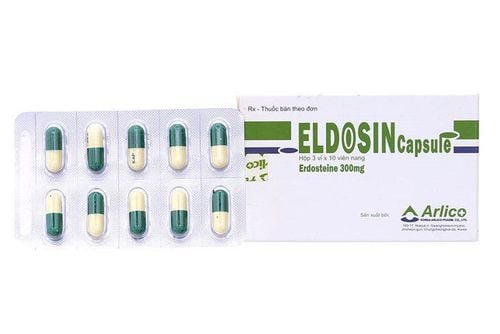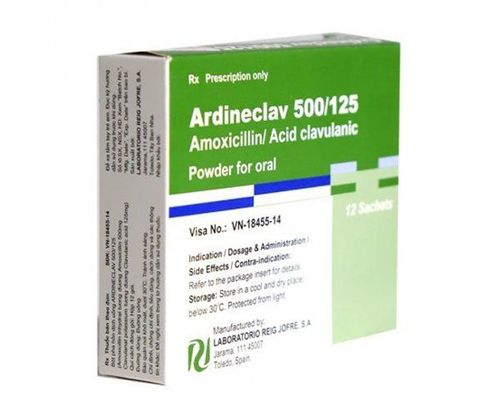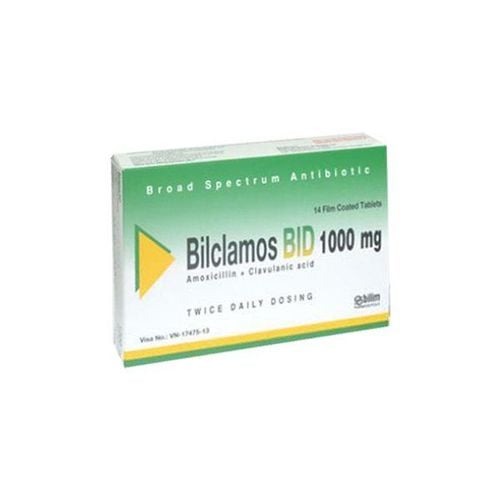This is an automatically translated article.
Imefed is a combination of the antibiotic Amoxicillin and Clavulanic Acid, used to treat a variety of infections. Imefed is available in 875/125mg and 500/125mg strengths.
1. What is Imefed?
Imefed is a product of Imexpharm Pharmaceutical Joint Stock Company, made in tablet form with ingredients including antibiotic Amoxicillin (in the form of Amoxicillin trihydrate compacted) content 500mg or 875mg and Clavulanic Acid (in the form of potassium Clavulanate - Avicel). 125mg content.
2. What are the uses of Imefed?
Amoxicillin antibiotic in Imefed is an Aminopenicillin, stable in acidic environment and has a broader spectrum of bacteria than benzylpenicillin, especially against gram-negative bacilli. Similar to other penicillins, Amoxicillin is a bactericidal antibiotic through inhibition of mucopeptide biosynthesis on bacterial cell walls. Amoxicillin is sensitive to most strains of gram-negative and gram-positive bacteria such as non-penicillinase-producing Streptococcus (Streptococcus), staphylococci (Staphylococcus), Haemophilus Influenzae, Diplococcus Pneumoniae, Neisseria gonorrhoeae, Escherichia coli and Proteus mirabilis.
However, the Amoxicillin in Imefed is inactive against penicillinase-producing bacteria, especially methicillin-resistant staphylococcus, all strains of Pseudomonas (blue pus bacillus), and most strains of Klebsiella or Enterobacter.
The remaining ingredient in the drug Imefed is clavulanic acid, which is the result of fermentation of Streptomyces clavuligerus, which has a beta-lactam structure similar to penicillin, capable of inhibiting beta-lactamase enzymes caused by most strains of gram-negative bacteria. negative and secreted by Staphylococcus. In particular, clavulanic acid strongly inhibits plasmid-transmitted beta l-lactamases that cause resistance to penicillins and cephalosporins. Clavulanic acid itself has a very weak antibacterial effect. In addition, Pseudomonas aeruginosa (Blue latex bacillus), Proteus morganii and rettgeri, some strains of Enterobacter and Providentia are resistant to this active substance. The clavulanic acid in Imefed protects Amoxicillin from destruction by beta-lactamase enzymes and effectively extends the antibacterial spectrum of Amoxicillin to many bacteria normally resistant to Amoxicillin, other Penicillins and Cephalosporins.
It can be considered that the combination of Amoxicillin and clavulanic acid in Imefed is bactericidal against strains of Pneumococcus (pneumococcus), beta-hemolytic Streptococcus (streptococcus), Staphylococcus (staphylococci) sensitive to Penicillin unaffected. affected by penicillinase, Haemophilus influenzae and Branhamella catarrhalis (including strains that are potent beta-lactamase producers).
3. Pharmacological characteristics of the drug Imefed
Amoxicillin in Imefed is an Aminopenicillin group of antibiotics with broad antibacterial spectrum and pharmacokinetic characteristics as follows:
Absorption: Amoxicillin is stable in gastric acid. Absorption Imefed is unaffected by food, and has a faster and more complete rate and extent of absorption orally when compared with Ampicillin; Distribution: Amoxicillin is rapidly distributed into most body fluids, with the exception of brain parenchyma and cerebrospinal fluid. However, when the meninges are inflamed, Amoxicillin diffuses easily. After using 250mg Amoxicillin about 1-2 hours for the drug concentration in the blood to reach about 4-5mcg/ml and increase to 8-10mcg/l when taking 500mg dose; Elimination: More than 1⁄2 oral doses of Amoxicillin are excreted unchanged in the urine over a period of 6-8 hours. The half-life of Amoxicillin is approximately 1 hour, which may be prolonged in neonates and the elderly. In patients with renal impairment, the half-life of Amoxicillin is prolonged to approximately 7-20 hours.
4. Indications and contraindications of the drug Imefed
Imefed is indicated for the treatment of infections caused by strains of bacteria that are still susceptible to the drug, specifically as follows:
Imefed is used to treat upper respiratory tract infections (including ear, nose and throat infections) such as: tonsillitis , sinusitis , otitis media ; Imefed treats lower respiratory tract infections, including exacerbations of chronic bronchitis, lobar pneumonia and bronchopneumonia; Gastrointestinal infections such as typhoid fever; Genitourinary infections, such as pyelonephritis, gonorrhea, septic abortion or obstetric infections. Severe infections such as bacteremia , endocarditis and meningitis caused by bacteria sensitive to Amoxicillin are not suitable for use with Imefed , and instead should be initiated with a high dose parenteral route and if necessary . it may be advisable to add another class of antibiotics; Imefed is also used for the prevention of endocarditis by preventing bacteremia that can develop into this disease. Besides, the drug Imefed should not be used in the following cases (Contraindications):
Patients who are allergic to Amoxicillin or other penicillins; Patients with cross-allergy to Cephalosporins; Patients with infectious mononucleosis or lymphoid leukemia; Caution should be exercised when Imefed is used in patients with a history of jaundice or liver dysfunction because clavulanic acid increases the risk of intrahepatic cholestasis.
5. Dosage of Imefed
Imefed is made in the form of tablets, so patients need to use the drug orally. Dosage references are as follows:
Adults and children over 12 years old weighing over 40kg: Dosage of Imefed drug calculated according to Amoxicillin: 500-625mg x 3 times/day or 1000mg x 2 times/day; Children 2 - 12 years old: Imefed dose calculated according to Amoxicillin: 30 - 60 mg/kg/day; Children under 2 years old: 30-40 mg/kg/day; Dosage of Imefed should be adjusted according to liver function and renal function.
6. Side effects of Imefed
Side effects of Imefed are low or rare and most of them are mild and temporary, including:
Hypersensitivity reactions such as skin rash, itching, urticaria; Erythema multiforme and Stevens-Johnson syndrome; Toxic skin necrosis, exfoliative bullous dermatitis and acute generalized exanthematous pustulosis (AGEP); Angioedema (Quincke's edema), anaphylactic reactions, serum sickness and hypersensitivity vasculitis; Interstitial nephritis; Imefed medicine causes some reactions on the gastrointestinal tract such as nausea, vomiting and diarrhea; Intestinal candidiasis or antibiotic-associated colitis (including pseudomembranous proctitis and hemorrhagic proctitis); Imefed can cause liver damage: Like other beta-lactam antibiotics, Imefed can cause hepatitis and cholestatic jaundice; Urinary crystals; Imefed may reduce the white blood cell count, transient platelet count and hemolytic anemia; Causes prolongation of bleeding time and prothrombin time; Central nervous system effects: Imefed may cause hyperactivity, dizziness and convulsions. In which convulsions can occur in patients with renal failure or taking drugs in high doses. Imefed is a combination of the antibiotic Amoxicillin and Clavulanic Acid, used to treat a variety of infections. To ensure the effectiveness of treatment and avoid unwanted side effects, patients need to strictly follow the instructions of the doctor, professional pharmacist.
Follow Vinmec International General Hospital website to get more health, nutrition and beauty information to protect the health of yourself and your loved ones in your family.
Please dial HOTLINE for more information or register for an appointment HERE. Download MyVinmec app to make appointments faster and to manage your bookings easily.













